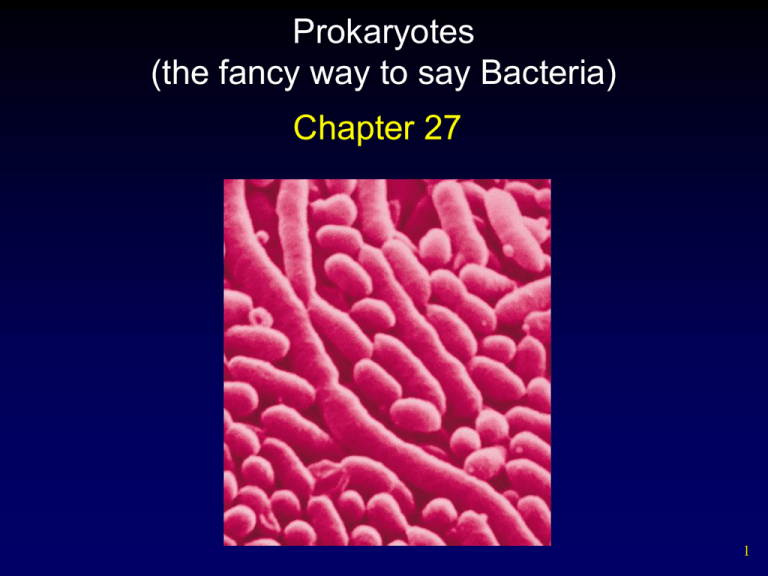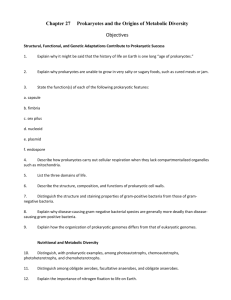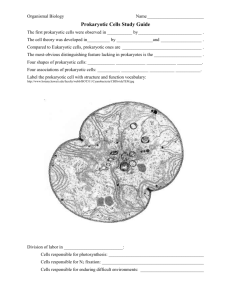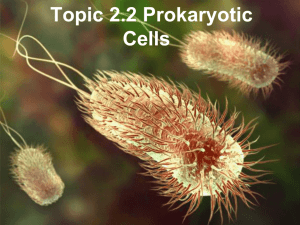Prokaryotes PowerPoint
advertisement

Prokaryotes (the fancy way to say Bacteria) Chapter 27 1 Outline • • • • • • • Prevalence of Prokaryotes Prokaryotic Diversity Prokaryotic Complexity Prokaryotic Variation Prokaryotic Metabolism Human Bacterial Diseases Benefits of Prokaryotes 2 Prevalence of Prokaryotes • • • In almost every place or environment microbiologists (scientists who study small organisms) look, prokaryotes have been found. – Hot springs, hypersaline environments, highly toxic gaseous environment, within clean rooms of hospitals In the 1980’s a new method of classification was used Divided prokaryotes into 2 groups: – Archaebacteria (Archae) and bacteria 3 Prevalence of Prokaryotes • Prokaryotes are the oldest, structurally simplest, and most abundant forms of life on earth. – abundant for over 2 billion years before the appearance of eukaryotes – Prokaryotic synthesis (from cyanobacteria) is thought to have been the source for much of the earth’s oxygen in atmosphere – 5,000 different kinds currently recognized 4 Structure of a Prokaryotic Cell 5 Structure of a Prokaryotic Cell • • • • • Most prokaryotic cells are small and lack interior organization. The plasma membrane is enclosed within a rigid cell wall DNA not contained within a membranebounded nucleus. Prokaryotes exteriorly may have a flagellum and other outgrowths called pili. Pili aid in attachment to other cells 6 Prevalence of Prokaryotes • • • • Prokaryotic form – bacillus (bacilli) straight and rod-shaped – coccus (cocci) spherical shaped – spirillum (spirilla) long and helical shaped Some bacillus and coccus bacteria form colonies Spirilla generally do not form colonies and are often free swimming Some bacterial colonies form spore producing structures. 7 Prevalence of Prokaryotes Prokaryotic form Coccus – Diplococcus pairs – Streptococcus chains – Tetrad quads • 8 Prevalence of Prokaryotes Coccus Sarcina Staphalo 9 Prevalence of Prokaryotes Bacillus Single Strepto coccobacillus (no pics) 10 Prevalence of Prokaryotes Spiral Types Vibrio Comma shaped Sprillium Thick rigid spiral Spirochete Thin flexible 11 Prevalence of Prokaryotes • Prokaryotes versus Eukaryotes – unicellularity – cell size – No internal compartments (mitochondria or chloroplasts) only organelle is the ribosome flagella – binary fission (asexual) internal compartmentalization – “naked” (no protein) circular DNA located in nucleoid cell division and recombination – 1 μm or less in diameter May vary by 5 orders of magnitude chromosomes – some may form filamentous matrices Single protein flagella of flagellin Spin like propellers instead of whiplike metabolic diversity Several kinds of anaerobic and aerobic photosynthesis Chemoautotrophs 12 Prokaryotic Diversity • Original key classification characteristics – photosynthetic or nonphotosynthetic – motile or nonmotile – unicellular or colony-forming or filamentous – spore formation by division or transverse binary fission 13 Prokaryotic Diversity • Now prokaryotic classification completed with genetic and molecular approaches – Analysis of amino acids sequence of key proteins – Nucleic acid analysis by establishing % guanine (G) and cytosine (C) – nucleic acid hybridization – ribosomal RNA sequencing – whole genome sequencing 14 Kinds of Prokaryotes • Very early, prokaryotes split into two lines – Archaea and bacteria are as different in structure and metabolism from each other as either is from eukarya. Archae (archebacteria) not actually as old as Bacteria 15 Prokaryotic Diversity • Comparing archaebacteria and bacteria – plasma membranes composed of different lipids – cell wall archaebacteria lack peptidoglycan – gene translation machinery Bacteria ribosomal proteins and RNA polymerases different from eukaryotes archaebacteria similar to eukaryotes – gene architecture bacteria genome not interrupted by introns some archaebacteria posses introns 16 Prokaryotic Complexity • Prokaryotic cell surface – identifying features – cell wall maintains shape and protects the cell from swelling and rupturing usually consist of peptidoglycan Gram-positive - thicker peptidoglycan (purple color after stain) Gram-negative - thinner peptidoglycan (red color after stain) – flagella – slender protein - locomotion – pili - hairlike structures – attachment (7.5 – 10 nm) – endospores - resistant to environment 17 Gram Stain 18 Flagellar Motor 19 The Cell Interior • • • Internal membranes – invaginated plasma membrane for respiration and/or photosynthesis Nucleoid region – lack nucleus - genes encoded with single doublestranded DNA *Prokaryotes often posses plasmids: independently replicating circle of DNA that contain only a few genes (not usually essential for survival) Ribosomes – Prokaryotic ribosomes are smaller than eukaryotic ribosomes, and differ in protein and RNA content. – Some antibiotics (tetracycline and chloramphenicol) bind to prokaryotic ribosomes to block protein synthesis 20 The Cell Interior • • • Internal membranes – (a) aerobic bacterium exhibits extensive respiratory membranes within cytoplasm – (b) cyanobacterium has thylakoid-like membranes that provide sites for photosynthesis Do you think that it is likely that photosynthetic and respiratory membranes evolved more than once? How could your idea be tested experimentally? 21 Processes to Create Prokaryotic Variation mutation – spontaneous errors in DNA replication prokaryotic ability to mutate rapidly often has adverse effect on humans – Radiation, UV light, and various chemicals (mutagens) cause DNA replication errors – Normal mutation rate 1 per million bases – E. coli has 5000 genes – This means that 1 out of every 200 bacteria will have a mutation – 1 spoonful of soil has 1 billion bacteria, so there should be 5 million mutant individuals per spoonful! 22 Processes to create Prokaryotic Variation mutation – with sufficient nutrients, a typical bacterium population could double in 20 minutes. – this allows for mutations to spread rapidly – individual bacterium not killed by an antibiotic can then reproduce rapidly and after 30 generations (10 hours) there would be over 1 billion clones of this resistive bacteria – Some hospitals now have strains of Staphyloccus aureus that are penicillin resistant – Why then could antibiotic soaps be a problem? – Why should you take all 10 days of your medication? 23 Processes to create Prokaryotic Variation mutation –figure 27.7 24 Processes to create Prokaryotic Variation • genetic recombination – occurs by gene transfer from one cell to another by viruses or conjugation conjugation: temporary union of 2 unicellular organisms, during which genetic material is transferred from one cell to another. – this is another method that can lead to resistant bacteria 25 Prokaryotic Metabolism • Autotrophs – obtain carbon from inorganic CO2 photoautotrophs – use sunlight to build organic molecules from CO2 chlorophyll a as pigment and H20 as electron donor bacteriochlorophyll as pigment and H2S as electron donor chemoautotrophs - inorganic chemicals obtain energy by oxidizing inorganic substances Nitrifiers – oxidize ammonia or nitrite On ocean floors H2S is oxidized as it escapes from thermal vents 26 Prokaryotic Metabolism • Heterotrophs – obtain carbon from organic molecules photoheterotrophs – sunlight + organic C purple non-sulfur bacteria organic molecules such as carbohydrates or alcohols source for C chemoheterotrophs (most prokaryotes) carbon and energy from organic molecules most decomposers and pathogens 27 Prokaryotic Metabolism • How heterotrophs infect host organisms – proteins secreted by type III system may be used to transfer other virulence proteins into nearby eukaryotic cells 28 Human Bacterial Diseases • • Tuberculosis – afflicts respiratory system and easily transmitted from person to person through the air Dental caries – tooth decay caused by bacteria present in plaque high sugar diets increase tooth decay lactic acid bacteria ferment sugars and reduce pH, thus degenerating tooth enamel 29 Human Bacterial Diseases • Sexually transmitted diseases – Gonorrhea (Neisseria gonorrhoeae) – Syphilis (Treponema pallidum) – Chlamydia (Chlamydia trachomatis) 30 Benefits of Prokaryotes • • Environment – chemical cycling – decomposition – nitrogen fixation reduces N2 to NH3 Symbiotic properties – nitrogen-fixation – digestive tract of animals 31 Benefits of Prokaryotes • • Genetic engineering – nonpolluting insect control – bioremediation pollutant removal – biofactories commercial production of antibiotics Bioweapons – anthrax – smallpox 32 Bioremediation 33







